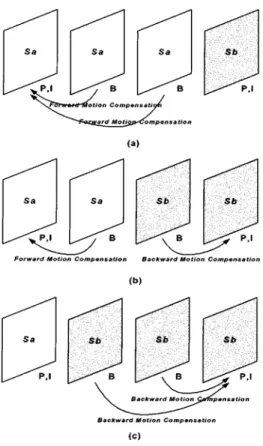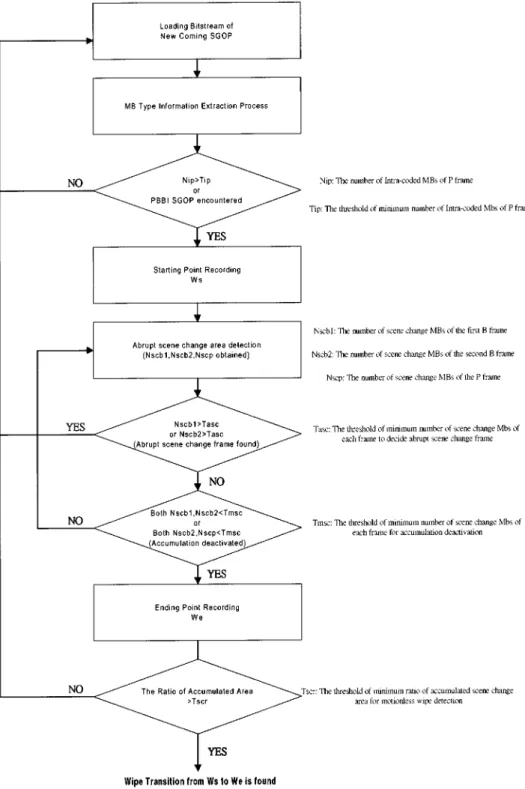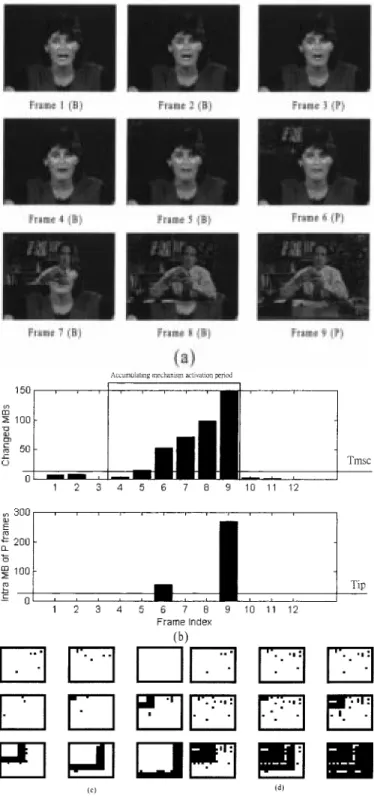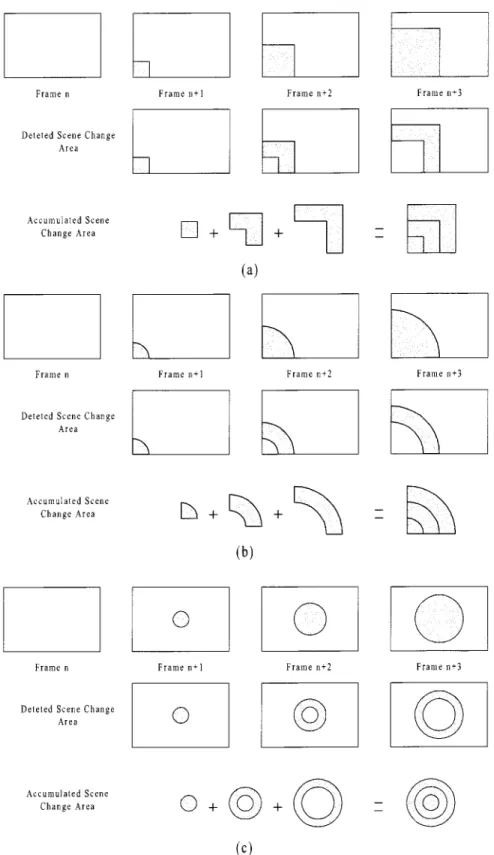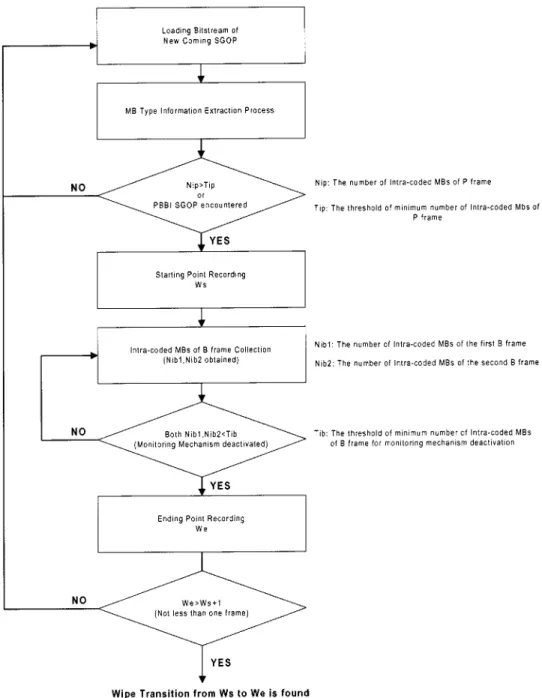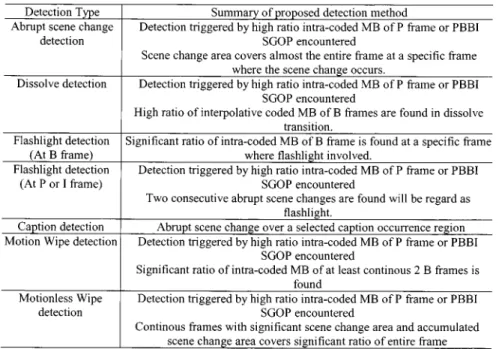Effective Wipe Detection in MPEG Compressed
Video Using Macroblock Type Information
Soo-Chang Pei, Fellow, IEEE, and Yu-Zuong Chou
Abstract—For video scene analysis, the wipe transition is con-sidered most complex and difficult to detect. In this paper, an ef-fective wipe detection method is proposed using the macroblock (MB) information of the MPEG compressed video. By analyzing the prediction directions of B frames, which are revealed in the MB types, the scene change region of each frame can be found. Once the accumulation of the scene change regions covers most area of the frame, the sequence will be considered a motionless wipe transition sequence. Besides, uncommon intracoded MBs of the B frame can also be applied as an indicator of the motion wipe transition. A very simple analysis based on small amount of MB type information is sufficient to achieve wipe detection directly on MPEG compressed video. Easy extraction of MB type information, low-complex anal-ysis algorithm and robustness to arbitrary shape and direction of wipe transitions are the great advantages of the proposed method. Index Terms—MPEG, scene change, scene cut, wipe detection, video analysis.
I. INTRODUCTION
A
S THE rapid development of multimedia applications, the video database is growing extremely huge. Nowadays, the video database management and video retrieval system have also become an urgent issue to be solved. To achieve the goal of video database management, how to parse a video sequence into a set of key frames plays a very important role. Video analysis, which detects those frames carrying significant infor-mation, such as scene changes or caption embedded frames, acts as the fundamental step to facilitate the video retrieval and browsing mechanism. Recently, as a result, the scene change detection method arouses more and more interests and many re-lated algorithms have been proposed. Generally, scene changes are subjectively divided into two types, abrupt scene change and gradual scene change, each represents different character-istics and requires different detection methods. Abrupt scene change, defined as sudden change from one scene to another caused by the video editing action, can be detected either by histogram comparison [3], [9] on the uncompressed video, or by discrete cosine transform (DCT) coefficient comparison [4], [5], [8] and analysis on motion vectors [6], [7], [11], [12] on the compressed video. We also have proposed an effective abrupt scene change detection based on an analysis of macroblock in-formation [23], which explores and reuses comparisonopera-Manuscript received December 5, 2000; revised July 23, 2001. This owrk was supported by the National Science Council ot Taiwan, R.O.C., under Contract NSC 91-2219-E-002-044. The associate editor coordinating the review of this paper and approving it for publication was Dr. Hong-Yuan Mark Liao.
The authors are with the Department of Electrical Engineering, National Taiwan University, Taipei, Taiwan, R.O.C. (e-mail: pei@cc.ee.ntu.edu.tw).
Digital Object Identifier 10.1109/TMM.2002.802841.
tions of the motion estimation procedure and can be applied di-rectly on the MPEG compressed video. Compared with abrupt scene changes, however, gradual scene changes not only require more complex detection method but also probably produce dis-turbances on the abrupt scene change detection. It is a transi-tion from one scene to another, which may take from several to several tens of frames. Most of gradual scene change detection papers [10], [14], [15], [21], [27] have put their focus on the dis-solve transition, during which the current scene gradually fades out and next scene gradually comes into sight. We also have pro-posed a dissolve sequence detection [23] using macroblock in-formation of P and B frame in the MPEG coding scheme, which explore the relationship between dissolve formula and the sta-tistics of interpolated MBs.
Besides the dissolve sequence, there also exists another common gradual scene change, the wipe transition. During the wipe transition, the next scene gradually shows up and wipes out the current scene. Compared with the dissolve sequence, the wipe sequence detection method is less discussed and much more complex. The difficulties of wipe detection lie in four respects, aas follows.
1) The arbitrary shape. The wipe shape can be arbitrary, such as rectangular, circle, fencing, etc.
2) The arbitrary direction. The wipe direction can be arbi-trary, such as bottom to top, top to bottom, bottom-left to top-right, etc.
3) The arbitrary speed. The wipe speed of a wipe transition can be arbitrary, which may spread over from several to several tens of frames.
4) Foreground or background movement. The next wipe-in scene or the current wipe-out scene can gradually appear or disappear with motion instead of motionless appear-ance or disappearappear-ance.
In order to explain this complexity, Figs. 1–5 illustrate the five different types of wipe transitions. Based on the above dis-cussion, the richness of variety of wipe transitions makes it the most difficult gradual scene change to be detected. Some of re-lated approaches perform the wipe detection based on uncom-pressed video [17], [18]. Although good performance is ob-tained, high computation load is required to handle the different shapes, directions and patterns of the wipe effects. Additionally, as the MPEG standard is widely adopted, more and more video data are compressed in order to save the storage space. In other words, uncompressed video wipe detection has to spend addi-tional computation power to decompress MPEG coded video in advance. As a result, more and more recent researches focus on wipe detection directly on compressed video. Wu et al. [19] have proposed a wipe detection based on the DC sequence of
Fig. 1. Example of wipe transition from the left to right in rectangular shape.
Fig. 2. Example of wipe transition form the upper-right to bottom-left in rectangular shape.
Fig. 3. Example of wipe transition from center to spread out in circular shape.
Fig. 4. Example of fencing wipe transition from left to right.
Fig. 5. An example of motion wipe transition from the left to right in rectangular shape.
MPEG compressed video. But it is only capable to detect hori-zontal and vertical wipes.
Based on our effective method of abrupt scene change detec-tion [23], we extend this idea to wipe detecdetec-tion. Taking advan-tage of the frame-based accuracy of abrupt scene change detec-tion and precise locating capability of scene change posidetec-tions, the wipe detection can be achieved by accumulating the scene change regions over a period of time. This method requires only macroblock type informaiton and is robust to arbitrary shapes,
directions and speeds of wipe sequences. For another type of wipe sequence in which the next scene is moving onto the cur-rent one, the number of intracoded MBs in B and P frames can also perform as the indicator of the wipe sequence effectively. Compared with other proposed methods, this novel method ben-efits from easy extraction and simple analysis of MB type in-formation. Above all, this proposed method works very effec-tively no matter where the initial location and in what direction or shape that the next scene wipes out the current one.
Fig. 6. Patterns of the prediction of B and P frame corresponding to different abrupt scene change positions.
Fig. 7. Illustration of concept of MBGxy.
II. PROPOSEDWIPEDETECTIONMETHOD
A. Abrupt Scene Change
We first introduce our proposed abrupt scene change detec-tion, which is applied as the first step of wipe detection. This method [23] exploits the comparison operations performed in the motion estimation procedure, which results in specific characteristics of the MB type information when abrupt scene changes occur. In the MPEG coding scheme with the Group Of Pictures (GOP) structure of IBBPBBPBBPBBPBB , we define the PBBP, IBBP, or PBBI as a SubGroup Of Pictures (SGOP) to clarify the description of our algorithm. The patterns of the prediction of B and P frames
Fig. 8. Illustration of motion and motionless wipe transition. (a) Illustration of motionless wipe transition. (b) Illustration of motion wipe transition.
Fig. 9. Illustration of the proposed motionless wipe detection method.
corresponding to different abrupt scene change positions are illustrated in Fig. 6. Based on this concept, abrupt scene changes can be detected by a simple analysis.
In addition, we define that the MBs in specific geometric position of each frame in a SGOP form a MB group (MBGxy). If the pattern of the MB types in a MBGxy follows the patterns shown in Fig. 6, a scene change MB in the location is found. This idea, which is illustrated in Fig. 7, can help us not only to locate the scene change area but also to set up the threshold more easily. The concept of MBGxy has been ap-plied to caption detection in our previous works [23] based on its ability to locate changed area.
It is worthwhile to note that our detection is in frame-based accuracy, in other words, our detection method can exactly indi-cates which areas have changed in each frame. This advantage
Fig. 10. Flowchart of proposed motionless wipe detection algorithm.
also provides us the opportunity to extend our method to detect wipe transition, which is a geometrically gradual scene change, based on accumulating scene change area.
B. Wipe Detection
Before introducing our wipe detection algorithm, we first classify the wipe transitions into two categories according to movement of the wipe-in or wipe-out scene. The motionless wipe transition, which is the most common form, is defined as the wipe transition without the foreground or background movement, that is to say, both wipe-in and wipe-out scene are
globally motionless. By contrast, in the motion wipe transition, the next wipe-in scene is moving onto the current wipe-out scene, or the current wipe-out scene is moving out and the next wipe-in scene shows up gradually. Fig. 8 illustrates these two categories of wipe transitions and the examples can be found in Figs. 1 and 5.
1) The Motionless Wipe Detection: As we have discussed,
the advantage of frame-based detection accuracy and the capa-bility to locate the scene change region facilitate the wipe de-tection. By our abrupt scene change detection, we can trace the changed area of each frame during the wipe transition. Once
the accumulation of changing area cover with significant ratio of the entire frame, the sequence will be judged as a wipe tran-sition. Fig. 9 illustrates the proposed motionless wipe detection method. Two important issues should be taken into consider-ation in our method: When to trigger the accumulconsider-ation mecha-nism and how long the accumulation should take. For the former issue, the simplest idea is to continuously monitor the detected scene change region, in other words, the accumulation mecha-nism is always activated. The computational load of this idea, however, is comparatively large. As a result, we adopt another solution that makes use of the significant number of intracoded MBs of the latter P frame of an SGOP. Because of the content change resulting from the wipe effect, the ineffectiveness of mo-tion estimamo-tion will result in significant number of intracoded MBs in P frames. This characteristic, which is also illustrated in Fig. 9, can be used to trigger the accumulation mechanism. Once the ratio of the number of intracoded MBs to total number of MBs exceeds a predefined threshold , the accumulation mechanism will start to detect scene change region for wipe de-tection. This idea, which avoid continuous effort on monitoring change area, is practical because the latter P frame of the SGOP will be decoded in advance of the B frames during the MPEG decoding process.
For the second issue to decide how long the accumulation should take, it is difficult because the length of the wipe tran-sition can be arbitrary. Consequently, a very large number of frames should be adopted as the threshold to cover all possible wipe transition lengths. This also costs a lot of computational power. In order to solve this dilemma, we change our strategy to set up the minimum threshold on the number scene change MB of the monitoring frame, instead of the fixed long mon-itoring length. Once the ratios of scene change MBs to total MBs of two consecutive frames drop smaller than the prede-fined threshold , the accumulation mechanism stops and the accumulation result is compared to the threshold . The motionless wipe detection is illustrated in the form of flowchart in Fig. 10, and Fig. 11 shows an experimental example based on proposed method, where each black dot represents a scene change MB. It is worthwhile to note that the scene change accu-mulation mechanism is triggered when I frames are encountered because there is no indication like what the intracoded MB of P frames shows.
There are two great advantages of the proposed method. First, the analysis of very low computational complexity can effec-tively achieve wipe detection, and most important of all, it can be directly applied on the MPEG compressed video. Second, the ability to track the change area of each frame and detec-tion based on accumuladetec-tion make our method robust to arbitrary shape and direction of the wipe effect. This advantage is illus-trated in Fig. 12.
2) The Motion Wipe Detection: The detection of motion
wipe transitions is a different case, in which the current wipe-out scene is gradually moving out of sight or the next wipe-in scene is gradually moving into sight. The character-istics of predictions, which exhibit in the MB types, depends on the moving speed. If the moving speed does not exceed the searching ability of the motion estimation, that is, the searching window, the patterns illustrated in Fig. 7 are still valid and the
Fig. 11. Experimental example of motionless wipe detection. (a) Test sequence for motionless wipe detection. (b) Statistics of changed MBs and intracoded MBs of P frames. (c) Abrupt scene change detection results based on MBGxy, where each black dot represents a scene change MB. (d) Accumulation of abrupt scene change regions based on MBGxy, where each black dot represents a scene change MB.
motion wipe detection is exactly the same as the motionless wipe detection introduced in Section II-B1. Once the moving speed exceeds the searching ability, however, the ineffective-ness of motion estimation makes our proposed motionless wipe detection invalid for this case. Fast moving speed will make nei-ther forward nor backward prediction of B frames adequate, but fortunately, the lack of adequate frames for prediction results
Fig. 12. Illustration of robustness of motionless wipe detection. (a) Rectangular wipe from bottom-left to top-right. (b) Circular wipe from bottom-left to top-right. (c) Circular wipe form center to edge.
in uncommon intracoded MBs of B frames. This phenomenon inspires us a new idea of motion wipe detection. The number of intracoded MBs of B frames can be used as the indicator to detect the motion wipe transition. Similar to motionless wipe detection, we have to decide when to trigger the monitoring mechanism to reduce the computational load. In practice, our method keeps on monitoring the number of intracoded MBs
of P frame to decide when to collect the MB type information of B frames. As we have described, this activation mechanism can be sucessful because the latter P is decoded in advance of B frames in an SGOP. Once the monitoring mechanism is triggered, the numbers of intracoded MBs of B frames will be collected and compared with a predefined threshold . If two consecutive B frames are found containing more than ratio
Fig. 13. Flowchart of proposed motion wipe detection algorithm.
of MBs are intracoded, our detection method will regard it as a wipe transition. Moreover, when two consecutive B frames are found containing less than ratio of MBs are intracoded during the monitoring activation period, ending point of a wipe tranistion is found. Fig. 13 shows the flowchart of our motion wipe detection algorithm and Fig. 14 shows an experimental example.
It is noted that our motion wipe detection is also robust to ar-bitrary shapes and directions of wipe transitions. It is because the decision is based on the quantity of intracoded MBs of B frames in which the shape or direction of wipe transitions has less influence. Besides, our motionless and motion wipe detec-tion can be integrated easily. Both of them are triggered using the number of intracoded MBs of P frames, and thus the ac-tivation mechanism can be merged. Once the monitoring and collecting MB type information of the B frame starts, the
inte-grated algorithm detects and accumulates scene change area of each frame, and simultaneously monitors the ratio of intracoded MBs of B frames. The detection will be terminated either when an ending point of the wipe transition is found, or when this se-quence is judged as nonwipe sese-quence.
III. SIMULATIONRESULTS
A. Edited Video Sequence
In order to examine the proposed method, a series of video sequences are edited for experiments. Each frame of these sequences is in SIF (352 240) format and encoded using
TM5 [16] ( Mbps). 45 wipe transitions (33
are motionless, other 12 are motion wipe transitions) are to be experimented, in which 30 are edited and 15 are digitized from real video. Inside this sequence, there are also 40 abrupt
Fig. 14. Experimental example of motion wipe detection. (a) Test sequence of motion wipe detection. (b) Statistics of MB type information of P and B frames.
scene changes, 12 dissolve, five zooming, and seven panning sequences. Before detection, a set of five threshold parameters needs to be decided in advance. This set is listed in Table I. These parameters are left to system user to adjust the trade-off between detection accuracy and false alarm rate and will be discussed and experimented later.
We first adopt a threshold set of
% % and the experimental results are shown in Table II. Fig. 15 has also shown how the detec-tion method operates and how the thresholds are applied. From Table II, it is found that very satisfactory detection accuracy and acceptable false alarm rate is achieved. The only miss detec-tion comes from a very long modetec-tionless wipe transidetec-tion. It pro-duces some small scene change area which will be rejected by threshold . The two false alarm comes from the very fast panning sequences and can be probably removed by increasing the threshold . Theoretically, adjusting the threshold can shift the tradeoff between false alarm and miss detection. In order to
TABLE II
EXPERIMENTALRESULTS OF45 WIPETRANSITIONDETECTION
(T = 15; T = 10; T = 15; T = 75%; T = 75%)
Fig. 15. Illustration of the proposed wipe detection method and the application of thresholds. (a) Statistics of intracoded macroblocks of P frames and the detected scene change MBs from frame1 to frame120 of the test sequence. (b)Experimental results of accumulating mechanism activation and accumulated scene change area.
understand the influence of these threshold parameters, a series of experiments are performed and shown in Table III to Table V. The results of Tables III–V are not very difficult to explain. If the is large, the long wipe transition may be missed
be-TABLE III
EXPERIMENTALRESULTSWITH THEDIFFERENTT
TABLE IV
EXPERIMENTALRESULTSWITHDIFFERENTT
TABLE V
EXPERIMENTALRESULTSWITHDIFFERENTT
cause there is a very small change area of each frame. Never-theless, when the small is adopted, the false alarm rate increases significantly. For , it can also be a very important factor to tune the tradeoff. If is large, the false alarm rate can be reduced but the miss detection increases. In contrast, small will induce more false alarm, primarily resulting from the camera motion or some large moving object, although the miss detection can be reduced significantly. has very similar ef-fect to from the findings of Table V. Therefore, the decision of threshold set selection can be left to the system user to tune the tradeoff between false alarm and miss detection.
B. Simulation of Real Video Sequence
We adopt five real video sequences digitized from news and commercial clips for further experiments. In these sequences, each is 9000 frames long and a total of 46 wipe transistions are involved. The experimental results are shown in Table VI. Forty-three wipe transitions are detected with only three false alarms using threshold set of
% % . Similar to the former experi-ments, the false alarms come from fast panning sequences and the miss detections come from very slow wipe transitions. How-ever, if you change the threshold set to
% % , 45 wipe transitions are found but false alarms also increase to nine.
IV. DISCUSSION
A. The Influence of Bit Rates
The bit rates of MPEG video streams can vary from one to several hundred Mbps. As a result, the influence of bit rates should be taken into account to verify the validity of the pro-posed method. Refer to the rate control mechanism of TM5, the rate is adjusted by changing the quantization scale and irrele-vant to macroblock type decision. The macroblock type is deter-mined by the temporal correlation between coding and reference
TABLE VI
EXPERIMENTALRESULTS OFNEWS ANDCOMMERCIALVIDEO CORRESPONDING TODIFFERENTTHRESHOLDSETS
frames. Therefore, the influence of the variation of bit rates is insignificant and, in other words, our method can perform well on the video streams of different bit rates. An experiment based on different bit rates has been done in [23] and simulation re-sults also support this point.
B. Different GOP Structure
In the MPEG standard, the encoder is not strictly defined so that different GOP structure can be used for MPEG coding. As a result, different type of prediction patterns of B frames should be adopted for different GOP structure. The algorithm of this paper is based on the GOP structure. As a result, here we also present the modifications of prediction patterns for different GOP structures, which are shown in Table VII.
C. Influence of Other Scene Change Detections
In practical applications, the proposed wipe detection should be able to be distinguished from other detections, such as abrupt scene change and dissolve transition detections. Table VIII shows the difference of different proposed effect detections and Table IX shows the MB patterns corresponding to different video scene contents. From Tables VIII and IX, we can find that five detection algorithms, which includes scene change, dissolve, wipe, flahslight and caption detections can be integrated without confusion.
V. CONCLUSION
A simple and efficient wipe detection algorithm is proposed using the MB type information. This method benefits from the easy extraction of MB type information, simple analysis, and robustness to arbitrary directions, shapes and foreground or background movement. Frame-based accuracy and the ability to locate the abrupt scene change area can be used to track the motionless wipe transitions by accumulating the scene change MBs. Besides, for the motion wipe detection, the number of intracoded MBs owing to the ineffectiveness of motion estima-tion can be used as the indicator. We have also discussed the influence of other effects, different bit rates and different GOP structures, and very satisfactory experimental results can be obtained. Last, we have to emphasize that this method is valid only when B frames are used in the MPEG coding process. As a result, the future work to integrate other methods using motion vectors or DCT coefficients is needed to cope with the sequence containing only I and P frames. Nevertheless, this situation is not common because most video sequence often contains B frames for the purpose of large storage space reduction.
TABLE VIII
DETECTIONMETHOD OFDIFFERENTEFFECTS ORSCENECHANGES
TABLE IX
REFERENCES
[1] A. Nagasaka and Y. Tanaka, “Automatic video indexing and full motion search for object appearances,” in Visual Database Systems, II, E. Knuth and L. M. Wegner, Eds., Amsterdam, The Netherlands: North-Holland, 1991, pp. 119–133.
[2] F. Arman, R. Depommier, A. Hsu, and M.-Y. Chiu, “Content-based browsing of video sequences,” in ACM Multimedia’94, Aug. 1994, pp. 97–103.
[3] F. Arman, A. Hsu, and M. Y. Chiu, “Feature management for large video databases,” Proc. SPIE, Storage and Retrieval for Image and
Video Databases, vol. 1908, pp. 2–12, 1993.
[4] Y. Nakajuma, “A video browsing using fast scene cut detection for an efficient networked video database access,” IEICE Trans. Inform. Syst., vol. E77-D, no. 12, pp. 1355–1364, Dec. 1994.
[5] F. Arman, A. Hsu, and M. Y. Chiu, “Image processing on compressed data for large video databases,” in Proc. First ACM Int. Conf.
Multi-media, Aug. 1993, pp. 267–272.
[6] H. J. Zhang, A. Kankanhalli, and S. W. Smoliar, “Automatic partitioning of full-motion video,” Multimedia Syst., vol. 1, pp. 10–28, July 1993. [7] H. J. Zhang, C. Y. Low, and S. W. Smoliar, “Video parsing and browsing
using compressed data,” Multimedia Tools Applicat., vol. 1, no. 1, pp. 89–111, Mar. 1995.
[8] B.-L. Yeo and B. Liu, “Rapid scene analysis on compressed video,”
IEEE Trans. Circuits Syst. Video Technol., vol. 5, pp. 533–544, Dec.
1995.
[9] K. Otsuji and Y. Tonomura, “Projection detecting filter for video cut detection,” in Proc. First ACM Int. Conf. Multimedia, Aug. 1993, pp. 251–257.
[10] S. F. Chang and D. G. Messerschmitt, “Manipulation and compositing of MC-DCT compressed video,” IEEE J. Select. Areas Commun., vol. 13, pp. 1–11, Jan. 1995.
[11] N. V. Patel and I. K. Sethi, “Compressed video processing for cut detec-tion,” in Proc. Inst. Elect. Eng., Vis., Image, Signal Process., vol. 143, Oct. 1996, pp. 315–323.
[12] , “Video shot detection and characterization for video databases,”
Pattern Recognit., vol. 30, no. 4, pp. 583–592, Mar. 1997.
[13] B.-L. Yeo and B. Liu, “Visual content highlighting via automatic ex-traction of embedded captions on MPEG compressed video,” in Proc.
SPIE, Digital Video Compression: Algorithms Technology, vol. 2668,
1996, pp. 38–47.
[14] J. Meng, Y. Juan, and S.-F. Chang, “Scene change detection in a MPEG compressed video sequence,” in Proc. SPIE, Digital Video
Compres-sion: Algorithms Technol., vol. 2419, 1995, pp. 14–25.
[15] Q. Wei, H. Zhang, and Y. Zhong, “A robust approach to video segmenta-tion using compressed data,” Proc. SPIE, Storage and Retrieval for Still
Image and Video Database, vol. 3022, pp. 448–456, 1997.
[16] L. A. Rowe, S. Smoot, K. Patel, B. Smith, K. Gong, E. Hung, D. Banks, S. T.-S. Fung, D. Brown, and D. Wallach, Berkeley MPEG Tools, Aug. 1995. Ver. 1.0, Rel. 2.
[17] A. M. Alattar, “Wipe scene change detector for use with video compres-sion algorithms and MPEG-7,” IEEE Trans. Consumer Electron., vol. 44, pp. 43–51, Feb. 1, 1998.
[18] W. A. C. Fernando, C. N. Canagarajah, and D. R. Bull, “Wipe scene change detection in video sequence,” in Proc. ICASSP, 1999, pp. 294–298.
[19] M. Wu, W. Wolf, and B. Liu, “An algorithm for wipe detection,” in Proc.
ICIP, 1998, pp. 893–897.
[20] S. J. Golin, “New metric to detect wipes and other gradual transitions in video,” Proc. SPIE, vol. 3653, pp. 1464–1474, 1998.
[21] M. Sugano, Y. Nakajima, H. Yanagihara, and A. Yoneyama, “A fast scene change detection on MPEG coding parameter domain,” in Proc.
ICIP, 1998, pp. 888–892.
[22] C. W. Ngo, T. C. Pong, and R. T. Chin, “Camera break detection by partitioning of 2D spatio-temporal images in MPEG domain,” in Proc.
IEEE Int. Conf. Multimedia Computing and Systems, 1999 , vol. 1, 1999,
pp. 750–755.
[23] S.-C. Pei and Yu.-Z. Chou, “Efficient MPEG compressed video analysis using macroblock type information,” IEEE Trans. Multimedia, vol. 1, pp. 321–333, Dec. 1999.
[24] N. Gamaz, X. Huang, and S. Panchanathan, “Scene change detection in MPEG domain,” in Proc. IEEE Southwest Symp. Image Analysis and
Interpretation, 1998, pp. 12–17.
[25] U. Gargi, R. Kasturi, and S. H. Strayer, “Performance chararterization of video-shot-change detection methods,” IEEE Trans. Circuits Syst. Video
Technol., vol. 10, pp. 1–13, Feb. 2000.
[26] K. Tse, J. Wei, and S. Pancanathan, “A scene change detection algorithm for MPEG compressed video sequences,” in Proc. Can. Conf. Electrical
and Computer Engineering, vol. 2, 1995, pp. 827–830.
[27] J. Meng, Y. Juan, and S.-F. Chang, “Scene change detection in a MPEG compressed video sequence,” in Proc. IS&T/SPIE Symp., vol. 2419, Feb. 1995, pp. 14–25.
[28] T. Shin, J.-G. Kim, H. Lee, and J. Kim, “Hierarchical scene change de-tection in an Mpeg-2 compressed video sequence,” Proc. 1998 IEEE Int.
Symp. Circuits and Systems, vol. 4, pp. 253–256.
Soo-Chang Pei (S’71–M’86–SM’89–F’00) was born in Soo-Auo, Taiwan, R.O.C., in 1949. He received the B.S.E.E. degree from National Taiwan University (NTU), Taipei, in 1970 and the M.S.E.E. and Ph.D. degrees from the University of California, Santa Barbara (UCSB), in 1972 and 1975, respec-tively.
He was an Engineering Officer in the Chinese Navy Shipyard from 1970 to 1971. From 1971 to 1975, he was a Research Assistant at UCSB. He was the Professor and Chairman in the Electrical Engi-neering Department, Tatung Institute of Technology and NTU from 1981 to 1983 and 1995 to 1998, respectively. Presently, he is the Professor of electrical engineering at NTU. His research interests include digital signal processing, image processing, optical information processing, and laser holography.
Dr. Pei received the National Sun Yet-Sen Academic Achievement Award in Engineering in 1984, the Distinguished Research Award from the National Science Council, R.O.C., from 1990 to 1998, the Outstanding Electrical Engi-neering Professor Award from the Chinese Institute of Electrial EngiEngi-neering in 1998, and the Academic Achievement Award in Engineering from the Ministry of Education in 1998. He has been President of the Chinese Image Processing and Pattern Recognition Society in Taiwan from 1996 to 1998, and is a member of Eta Kappa Nu and the Optical Society of America.
Yu-Zuong Chou was born in Tainan, Taiwan, R.O.C. He received the B.S. degree from the National Tsing Hwa University, Hsinchu, Taiwan, in 1994, and the M.S. degree from the National Taiwan University (NTU), Taipei, in 1996, both in electrical engineering. He is currently pursuing the Ph.D. degree in electrical engineering at NTU.
He served in the Taiwan Army as a Commu-nication Officer from 1996 to 1998. His current research interests include video compression and transmission, image processing and multimedia application.

